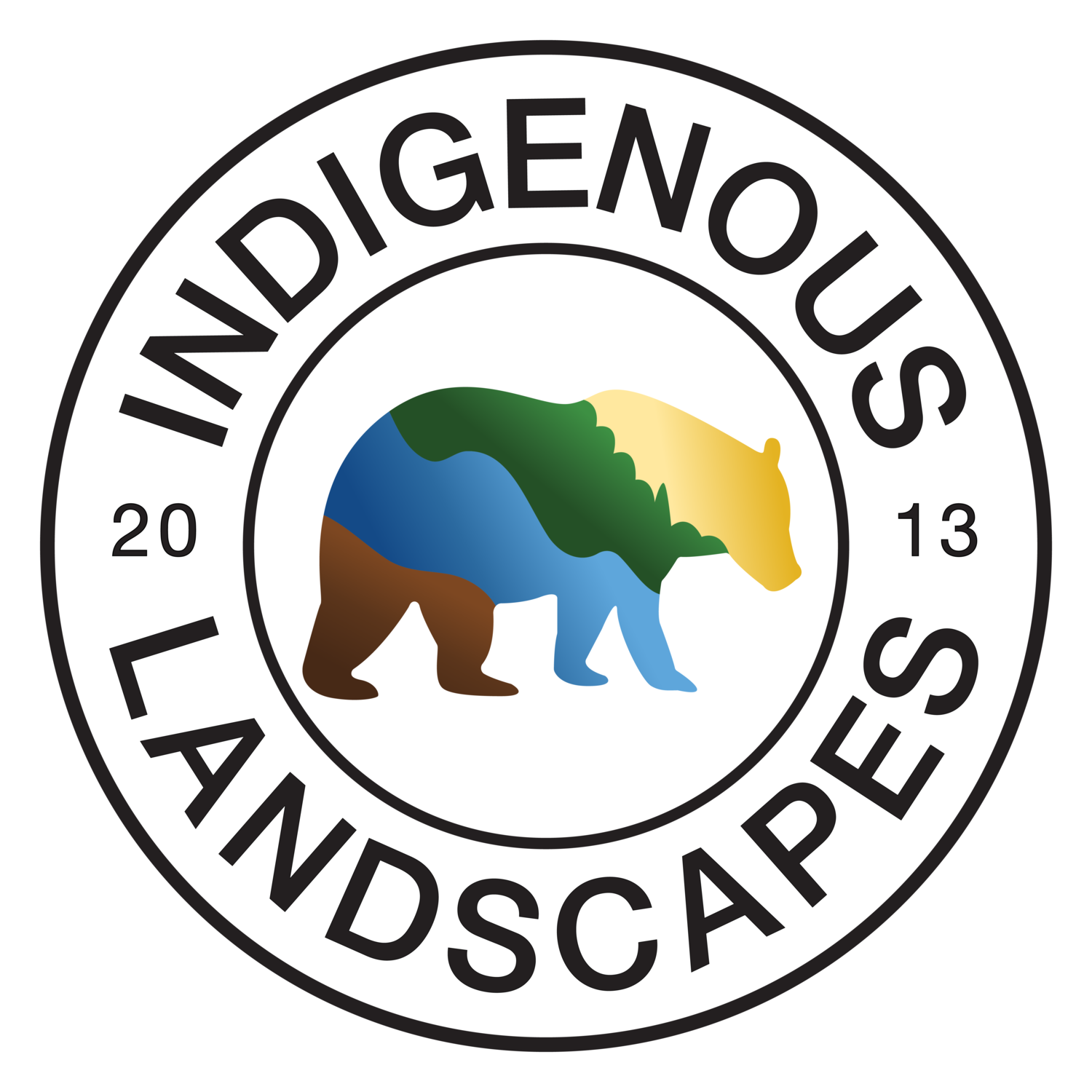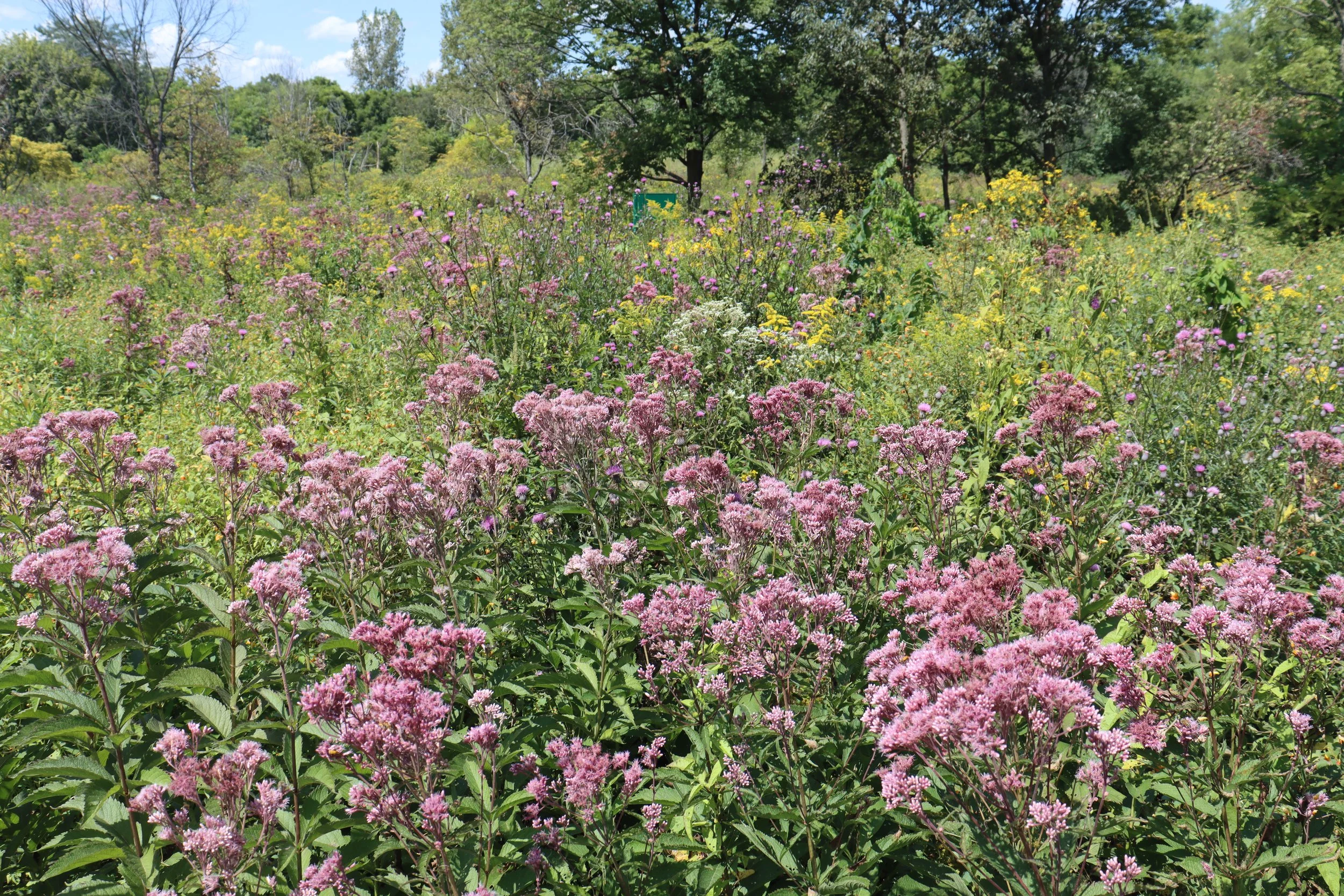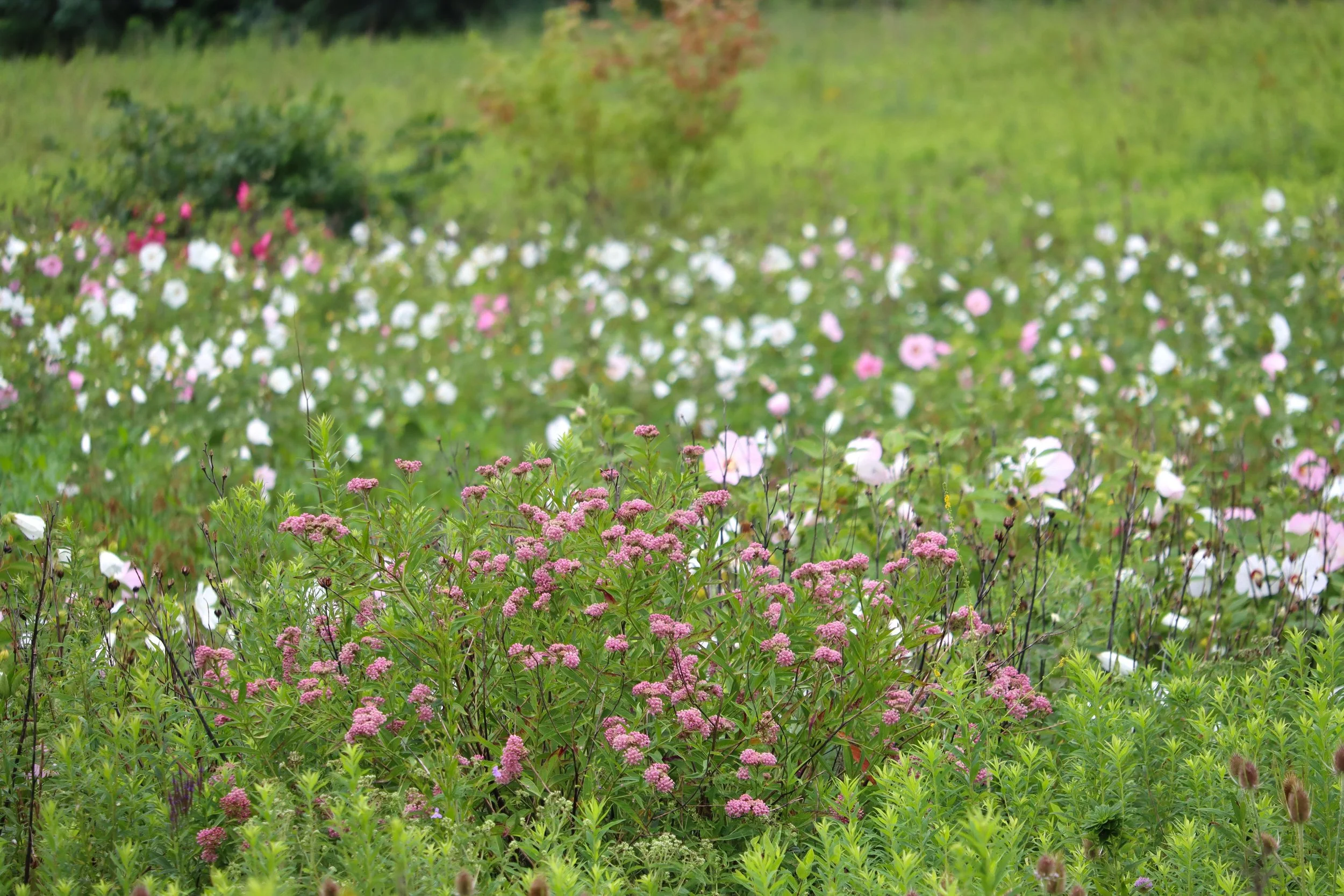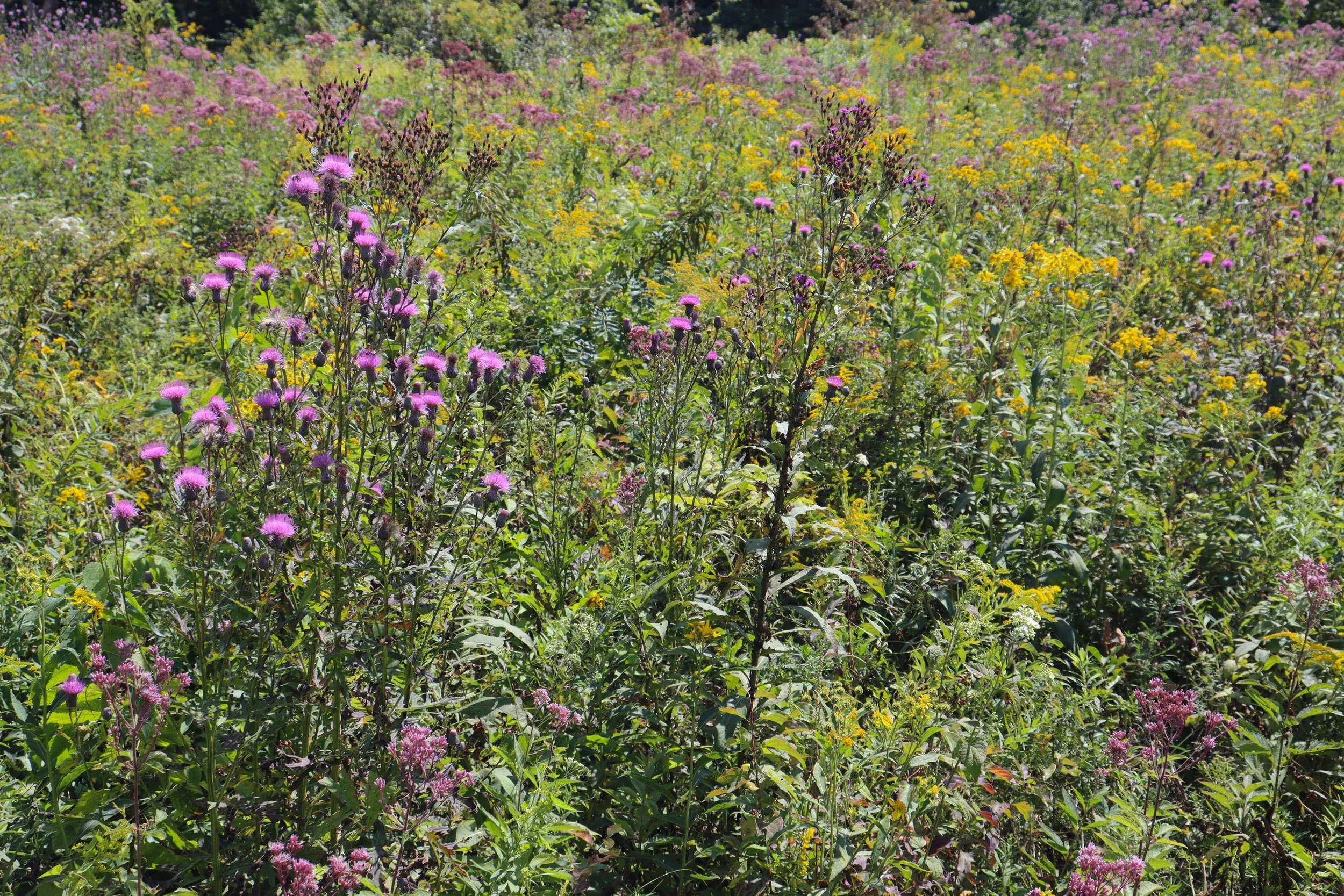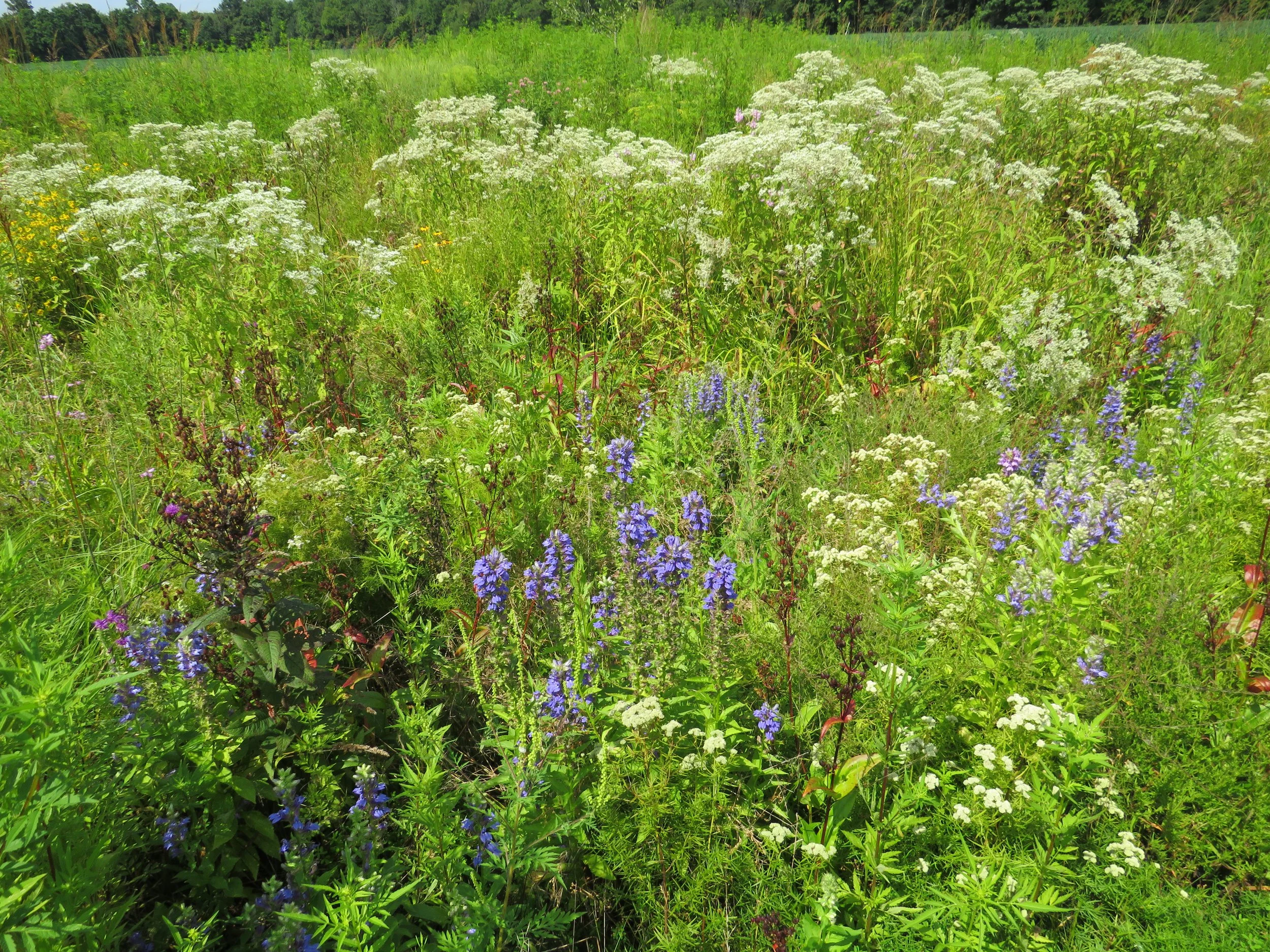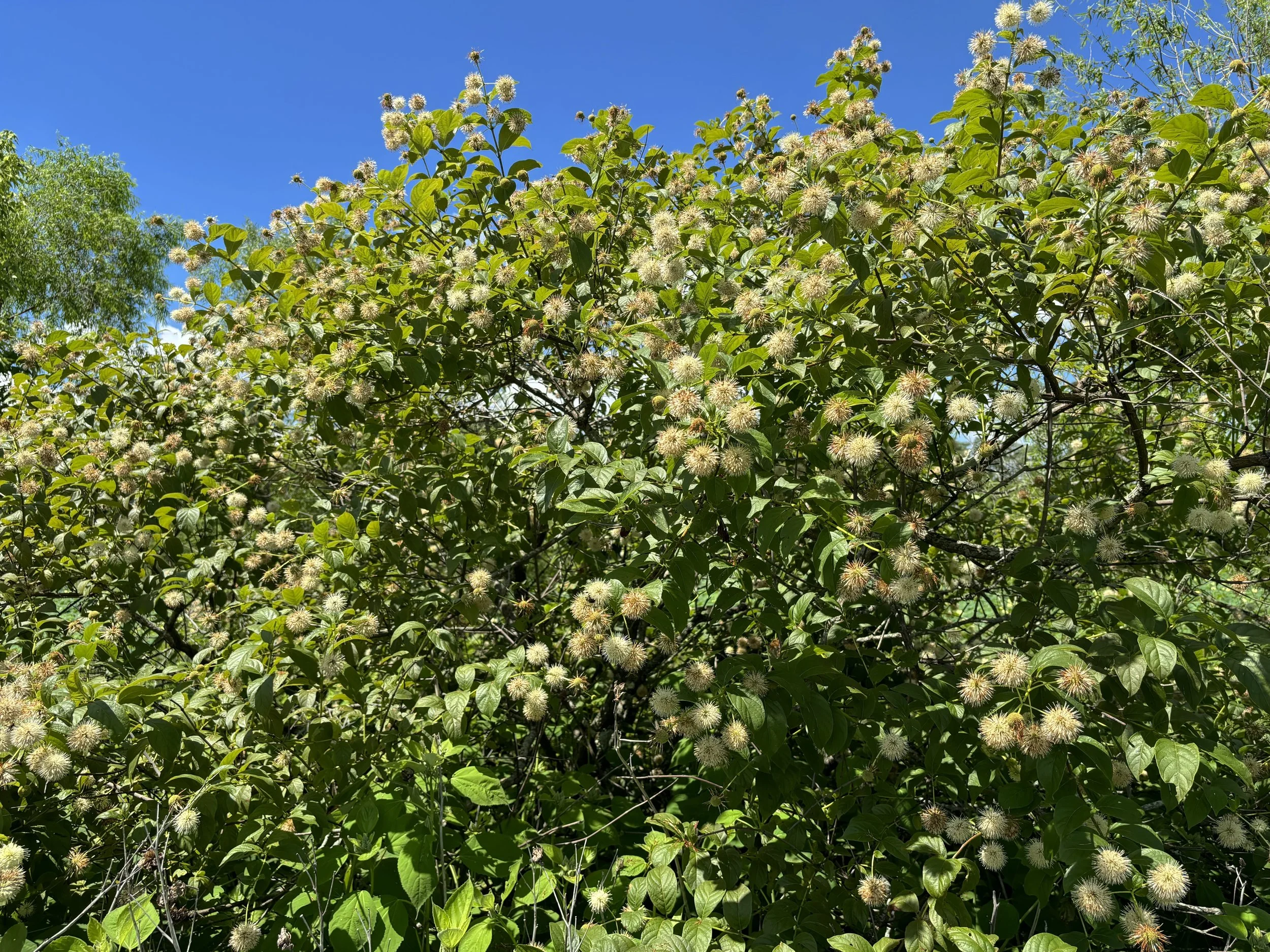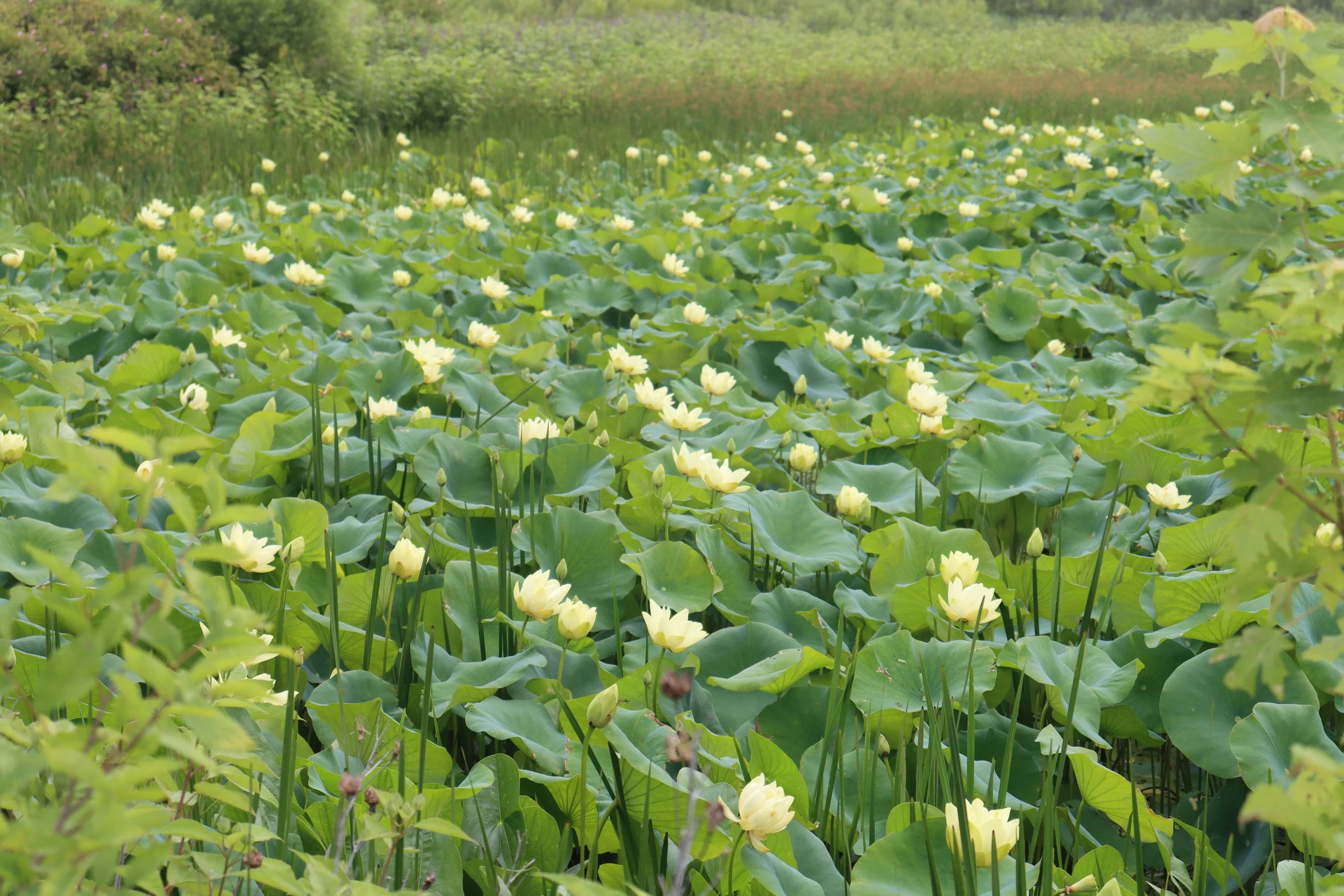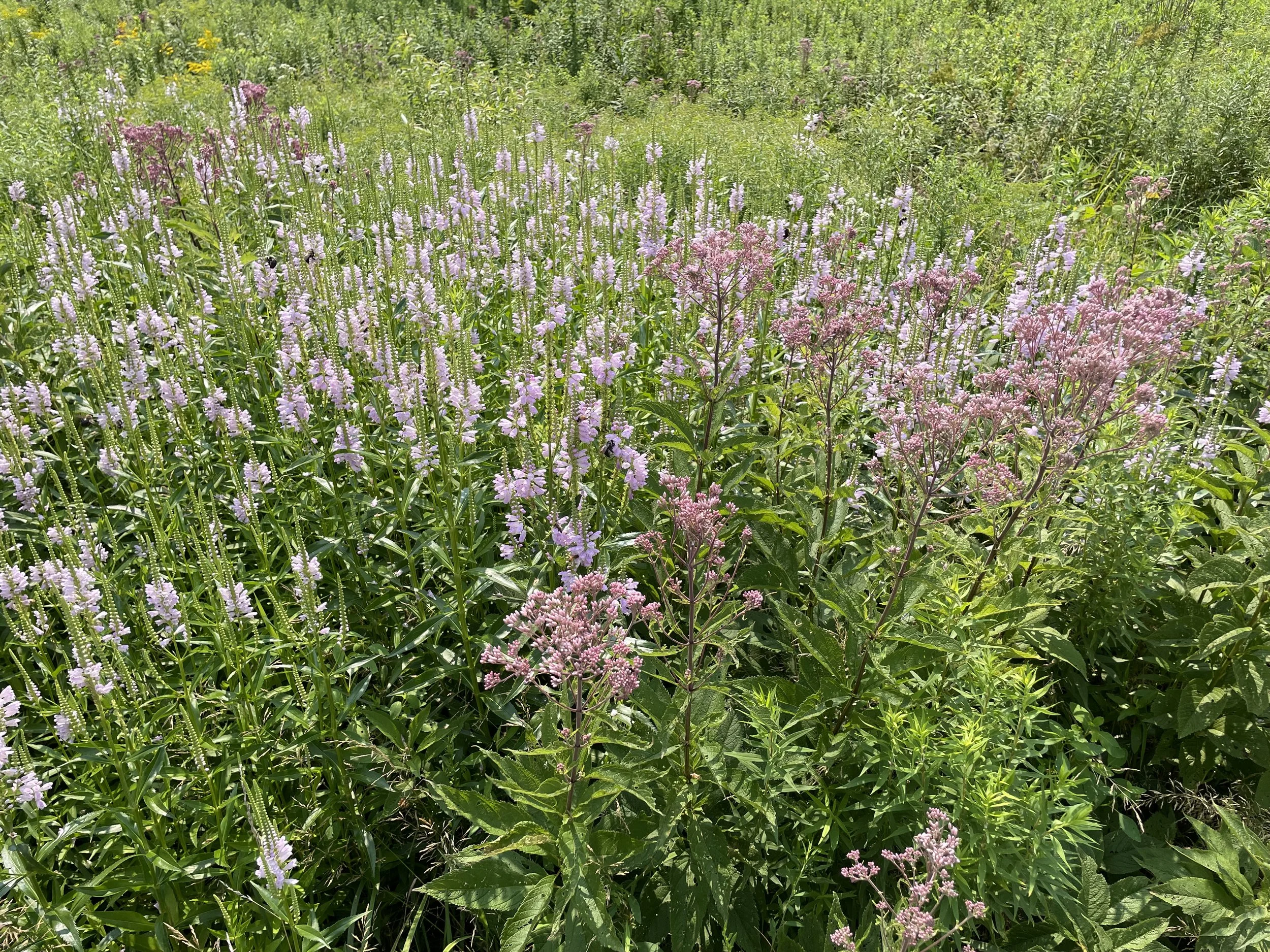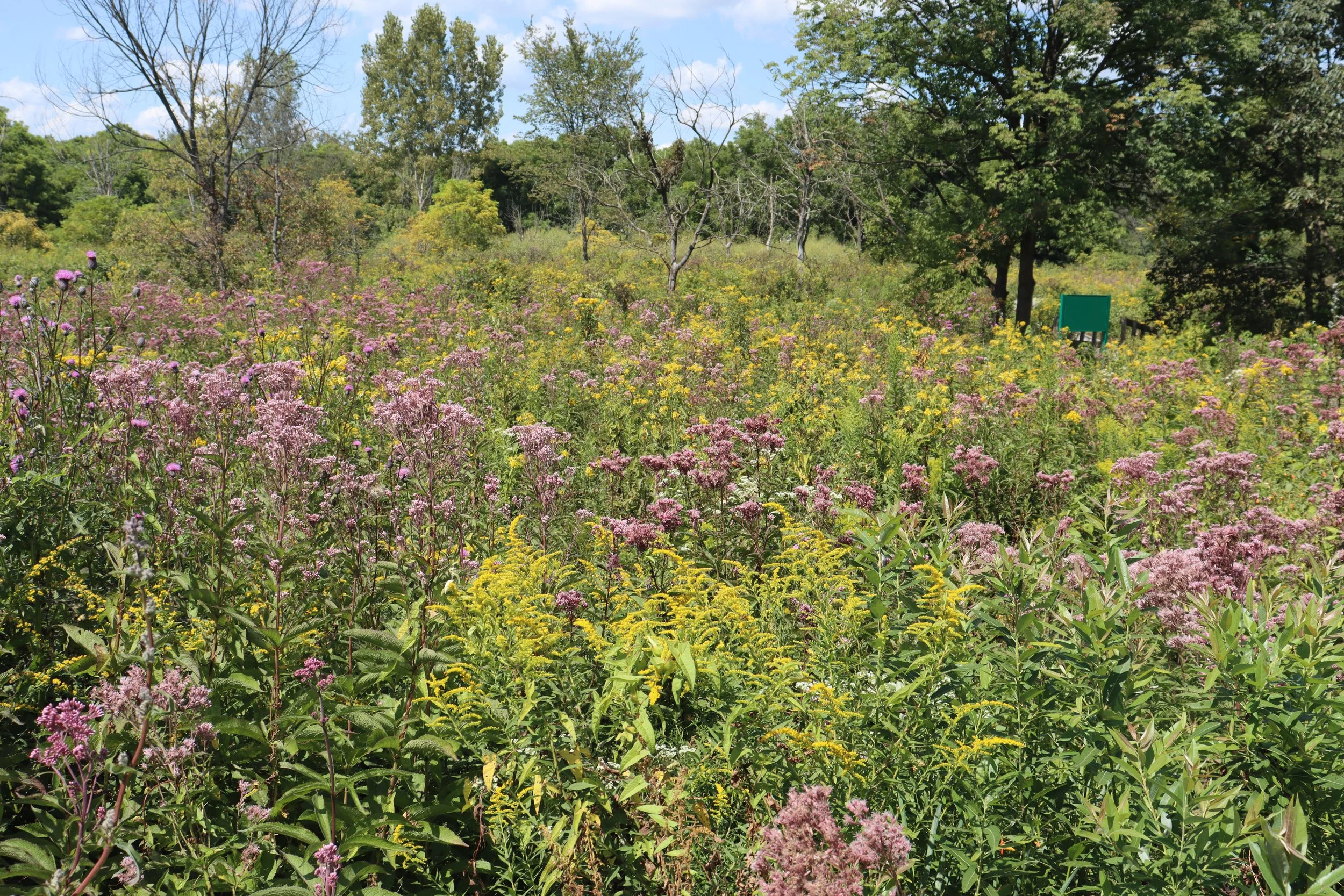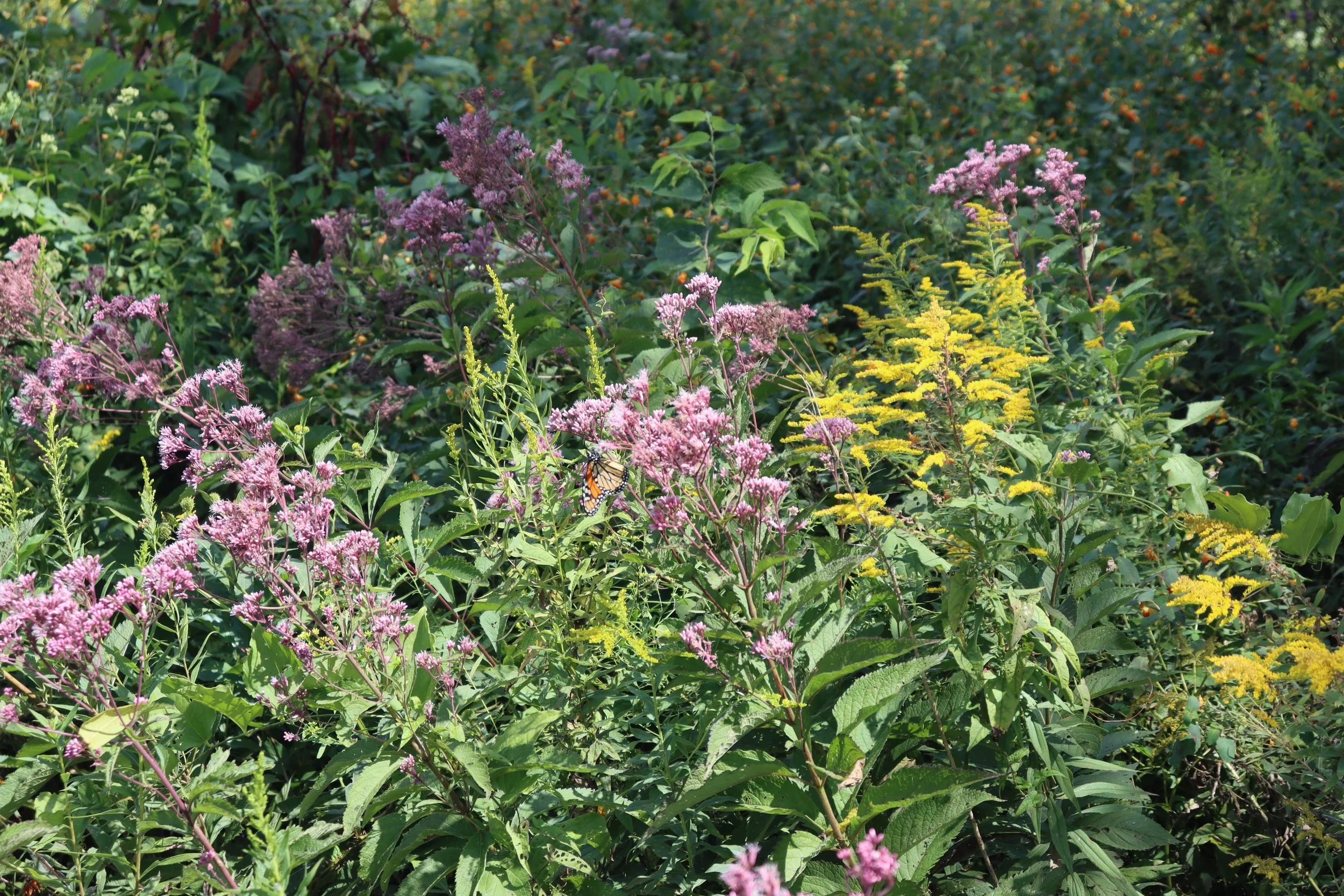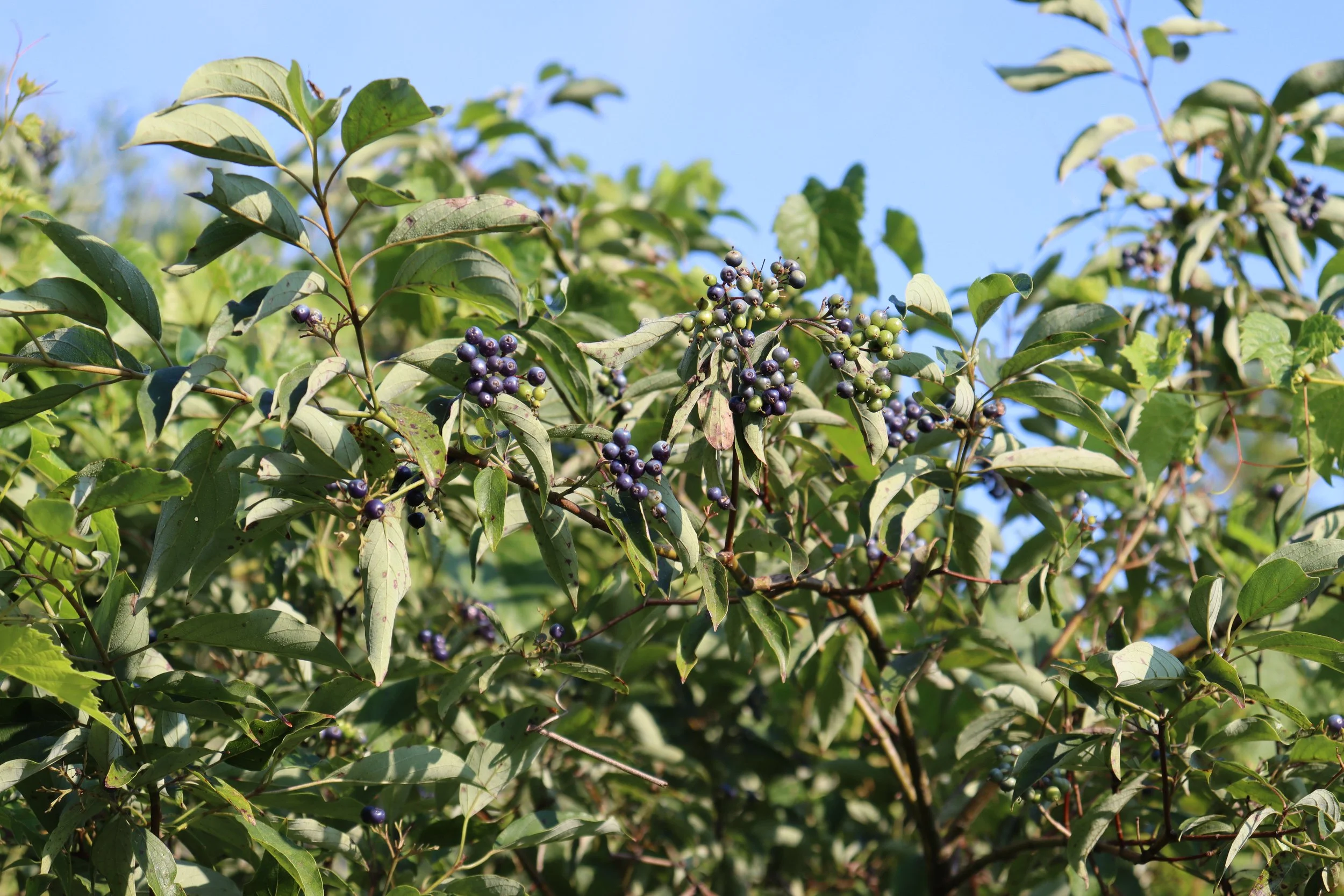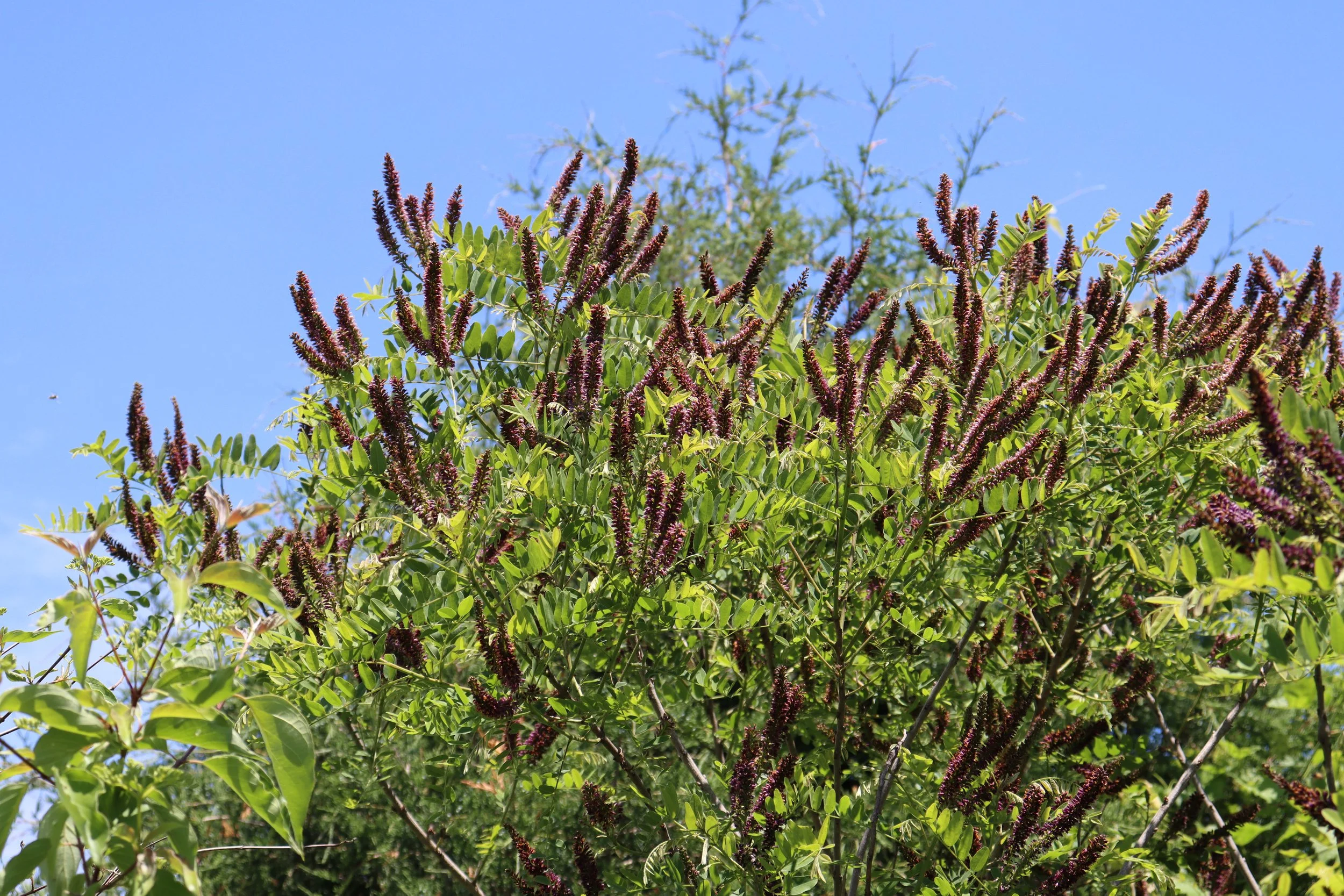Pearl’s Fen in Southwest Ohio, early September 2025. The primary visible blooms are Joe Pyeweed (Pink), Common Boneset (White), Wingstem (Yellow), Swamp Goldenrod (Yellow), Tall Goldenrod (Yellow), and Swamp Thistle (Darker Pink). This natural wetland features a high water table and spring fed creek throughout the year, even through dry spells and drought.
The Unique Value of Wet Areas to Pollinators in Late Summer
In the southern 3/4th’s of the eastern half of the United States, late summer often becomes a challenging time for native pollinators to find an abundance of nectar and pollen. From zone 5b and southward; the winter and spring snow/rain recharges the soil and water table of which plants use of most of this water during late spring through mid summer. If mid summer rains are not plentiful enough, native wildflowers in average to drier soils begin restricting growth and bloom endurance/time periods to save enough water to sustain their life. North of Zone 5b, late summer soils can surely still dry out from spring and summer droughts; it’s just more likely to happen south of Zone 5b.
This time from late - mid summer through late summer; wet areas can support explosive bloom displays if native wildflowers are preserved or restored there. In the wild landscape, this represents sunny flood plain openings and mucky riverside depressions. Sunny wetlands, fens, and bogs also still have moist enough soil in the late summer to support an abundance of resources for native pollinators. You may notice that the majority of wetland and wet soil tolerant native wildflowers don’t bloom until late into the middle of the summer continuing into early fall (Late July through September in Zone 6 for example) while in drier land such as prairies; the majority of native prairie wildflowers bloom early summer into the beginning of late summer (June into early August in Zone 6 for example). In this way prairies and wetlands are almost two sides of 1 coin with prairies capitalizing on late spring through midsummer topsoil and subsoil moisture before wetter areas climax in bloom in the parched season of late summer when most prairie wildflowers focus more on survival and conservation of water in drier years.
Swamp Milkweed graces the foreground of a large Rose Swamp Mallow population in the background.
The further south you are Located, the more uniquely important wet areas Can become.
This phenomena of drier and average moisture soils drying out enough to stunt pollinator resources in late summer becomes more pronounced the further south you are in the eastern half of the United States. This is due to the northern regions having a shorter growing season and cooler climate which results in a larger overlap of wildflower blooms as they have less time “to wait” to bloom that far north if they are to complete their seed production before the frost of fall. With the cooler climate, wildflowers in average or drier soils north of Zone 5b still often can produce an abundance of nectar and pollen mid to late summer. South of zone 5b the growing seasons become longer, the climate is warmer, and late summer becomes harder on pollinators especially in late summer before temperatures drop off in early fall ushering in the end-season of blooms featuring Asters and Goldenrods.
While these wet habitats are crucial for pollinators active in late summer, you don’t need to have a river, creek, or wetland in your yard to support native pollinators in the late summer…
Swamp Thistle - Cirsium muticum beams in the foreground of Pearl’s Fen nature preserve in southwest Ohio.
Wet Areas in Neighborhoods and other Human Spaces
In the heavily human altered landscape of neighborhoods; drainage ditches and low areas that handle storm water can be converted into wetland-like patches of native wildflowers that love these conditions. Sometimes residents live in areas with high water tables and soggy soils that stay saturated throughout the spring and early summer which can have moist subsoil in the late summer to support native plants like those featured in the pictures of this article. These soils can often look dry on the surface by early to mid summer, but still hold an abundance of moisture or even standing water about 10 to 18 inches below the soil surface. Diverting and concentrating rainwater from gutter spouts to create rain gardens also can create the rare wet spot in a parched late summer landscape. In Commercial and Industrial Landscapes large parking lots often have retention ponds to slow storm water runoff from the parking lots and on the edges of these retention pond there’s often a margin to plant a native wet soil love wildflower border.
A native vegetated stream near by the University of Kentucky, where high water flows in the winter and spring floods.
Installing Seed Mixes in Wet Areas with High Water Flows
In areas such as stream or riverbanks and storm water ditches; the moving water during high water periods present a unique challenge for installing native plants. Winter and Spring rains can rip away newly installed plugs or potted plants such as native shrubs if the current is strong enough. These Winter and Spring high water flows will also silt-over or scour away seed mixes installed in the fall season. For areas subjected to high water flows, you’ll need to seed - seed mixes in the spring after most of the winter and early spring high water flows have ended. Spring Seedings have been some of Indigeous Landscape’s most successful seedings, but only when the seed mix is pre-stratified through artificial means. Seeding in the spring means there will not be enough time for the seeds to naturally receive their cool moist stratification period that happens during the fall and winter seasons. This must be overcome by artificially stratifying your seed mix.
Artificially Stratifying your Seed Mix for a Spring Seeding
1. At a minimum; 30 days before you intend on seeding your seed mix: soak your seed with cold tapwater temperature water for about 4 to 6 hours.
2. Strain the seed from the water carefully, ensuring that smallest seeds don’t float out.
3. Mix the saturated seed with one parts seed to 2 or 3 parts coarse sand.
4. Place the seed mix in a plastic crate and place it outdoors on the surface of the soil on the Northside of a tall object such as a shed, house or detached garage where it gets no sunlight exposure.
5. Finally, cover up the crate, first with 6 to 8 inches of ice cubes on the sides and atop the crate. Then cover the ice with 10” to 18” inches of sand on both the sides and atop the crate. This will create a cool microclimate ideal for stratification.
After 14 days move the sand off of the top of the crate, replace the melted ice with fresh ice, and then put the sand back over the fresh ice. The sand will collapse when the ice has melted. After a minimum of 30 days of having begun this stratification process, the seed will be ready to apply to your site, but wait until the recommended temperature (noted below) low’s and high’s for a spring seeding.
Most ideally, the crate of your seed mix should remain under ice and sand for 30 to 45 days for maximum germination potential. You can place a thermometer deep inside the sand pile near the crate and aim to keep it between 33 and 42 degrees. If it gets above 42 degrees in this interior, remove the sand and apply more ice then reapply the sand for insulation. If you remove the sand after the initial 14 days and the seed mix smells “funky” like its mildewing or molding, do not apply more ice as the saturation will promote more fungus development. Instead put the sand back in place and plan on applying it at the 30 day mark instead of the 40 or 45 day mark. We’ve used funky smelling seed mixes before that started to mildew or mold while being artificially stratified, and they’re surprisingly still very much effective at germinating exhibiting minimal seed loss from the fungus development. Still, if fungus develops, stop applying ice, use sand as insulation, and apply at the 30 day mark.
Installing Seed Mixes in Wet Areas without High Water Flow
With wet fields, pond-side seedings, and other wet areas that are simply poorly drained (high water table); there won’t be stream/river-like water flows so you can simply seed them in the fall after preparing your site. For those areas, you can use our instruction manual to prepare your site for a native seed mix here.
Great Blue Lobelia stealing the show with it’s blueish spiked flowers completed by Common Boneset (white).
Native Wildflowers for Supporting Native Pollinators in Wet Areas
These Native Plants for wet areas are native to much of the eastern half of the United States. To find out where they are native google search their scientific name + the word “Bonap” for a native range map.
Native Wildflower Species for Wet Area Pollinator Support
Spring to Midsummer Flowering
Marsh Marigold - Caltha palustris, Foxglove Beardtongue - Penstemon digitalis, Northern and Southern Blue Flag Iris species, Great Angelica - Angelica atropurpurea, Queen of the Prairie Filipendula rubra, Swamp Milkweed - Asclepias incarnata, Monkey Flower - Mimulus rigens, Wild Mint Mentha arvensis, Slender Mountain Mint - Pycnanthemum tenuifolium, American Lotus - Nelumbo lutea, Cup Plant - Silphium perfoliatum, Blue Vervain - Verbena hastata
Late Summer Flowering (When pollinators need wet area flower production the most.)
Arrowhead species - Sagittaria species, Water horehound - Lycopus americanus, Obedient Plant Species (Physostegia species), Cardinal Flower - Lobelia cardinalis, Great Blue Lobelia - Lobelia siphilitica, Prairie Dock - Silphium terebinthinaceum, Groundnut - Apios americana, Ironweed Species (Vernonia species) Wingstem - Verbesina alternifolia, Cut-leaf Coneflower - Rudbeckia laciniata, Orange Coneflower Rudbeckia fulgida var. sullivantii, Hibiscus species, Meadow Beauty - Rhexia virginica, Common Sneezeweed - Helenium autumnale, Purple Headed Sneezeweed - Helenium flexuosum, Marsh Blazing Star Liatris spictata, Mistflower - Conoclinium coelestinum, Hollowstem Joe Pye Weed - Eutrochium fistulosum, Joe Pye Weed - Eutrochium maculatum, Common Boneset- Eupatorium perfoliatum, Orange Jewel Weed - Impatiens capensis, Tickseed Species - Bidens species, Tall Sunflower - Helianthus giganteus, Swamp Thistle - Cirsium muticum, Grassleaf Goldenrod - Euthamia graminifolia, Tall Goldenrod Solidago gigantea, Riddell’s Goldenrod Oligoneuron riddelli, Marsh Betony - Pedicularis lanceolata, Native Smartweeds (Native Persicaria species)
End of Summer/Early Fall Flowering
Various Aster species such as New England Aster - Aster novae-angliae, Swamp Aster - Aster puniceus. Various Goldenrod species such as Swamp Goldenrod - Solidago patula, Cananda Goldenrod - Solidago canadensis. Turtlehead - Chelone glabra, Pink Turtlehead Chelone obliqua, Swamp Sunflower - Helianthus angustifolius.
Buttonbush produces a great quantity of nectar and pollen judging by the frequency of density of pollinators using it.
Thicket Species for Supporting Wildlife and Pollinators in Wet Areas
Most thicket species bloom within the time period of early spring to early summer before seemingly giving way to midsummer through early fall Wildflower dominance when it comes to nectar/pollen production. So utilizing native thicket species helps to balance out seasonal nectar/pollen production. Thicket species also host unique insects consuming their vegetation that differ from those supported by eating native wildflower, sedge, and grass vegetation; diversifying the insect population. Thicket fruits/seeds also provide larger wildlife with food resources that native sedges, grasses, and wildflowers do not. We’ll provide a list of native thicket species that are good for the edges of wet areas where the soil transitions to better drained, and thicket species for directly in wet areas.
Thicket species for the edges of wet areas where the soil starts to become better drained: Red Chokeberry - Aronia arbutifolia, Black Chokeberry - Aronia melanocarpa, PawPaw - Asimona triloba, Musclewood - Carpinus caroliniana, Buttonbush - Cephalanthus occidentalis, Roughleaf Dogwood Cornus drummondii, American Hazelnut - Corylus americana, Beaked Hazelnut - Corylus cornuta, Sweet Crabapple - Malus coronaria, Southern Crabapple - Malus angustifolia, Prairie Crabapple - Malus ioensis, Ironwood - Ostrya virginiana, Ninebark - Physocarpus opulifolius, Cinquefoil - Potentilla fruticosa, Wild Plum species, Chokecherry - Prunus virginiana, Pasture Rose - Rosa carolina, Blackberry, Rapsberry, Dewberry - Rubus species, Staphylea trifolia - Bladdernut, Spicebush - Lindera benzoin, Prickly Ash - Zanthoxylum americanum
Thicket species for planting directly within wet areas: Amorpha fruticosa - False Indigo Bush, Silky Dogwood - Cornus amomum, Gray Dogwood - Cornus racemosa, Red Twig Dogwood - Cornus sericea, Winterberry Holly - Ilex verticillata, Swamp Rose - Rosa palustris, Climbing Rose - Rose setigera, Common Elderberry - Sambucus canadensis, Steeplebush - Spiraea tomentosa, Spicebush - Lindera benzoin in partial to full shade wet areas, Blueberry, Cranberry and other select Vaccinium species, Arrowwood Viburnum dentatum, Nannyberry - Viburnum lentago, and Native Willow species.
When considering planting a native plant, always google search the scientific name aka latin name with the word “bonap” to look up its native range as reported by country records submitted to herbariums. If the plant is native within 100 miles of your location it will be more ecologically applicable than plants native further away. The further away a plant is native, often, the less ecologically applicable it becomes.
